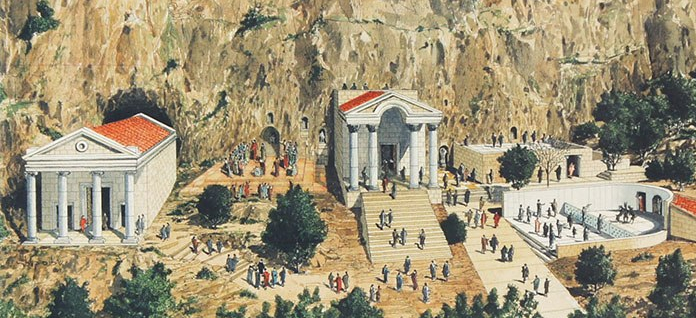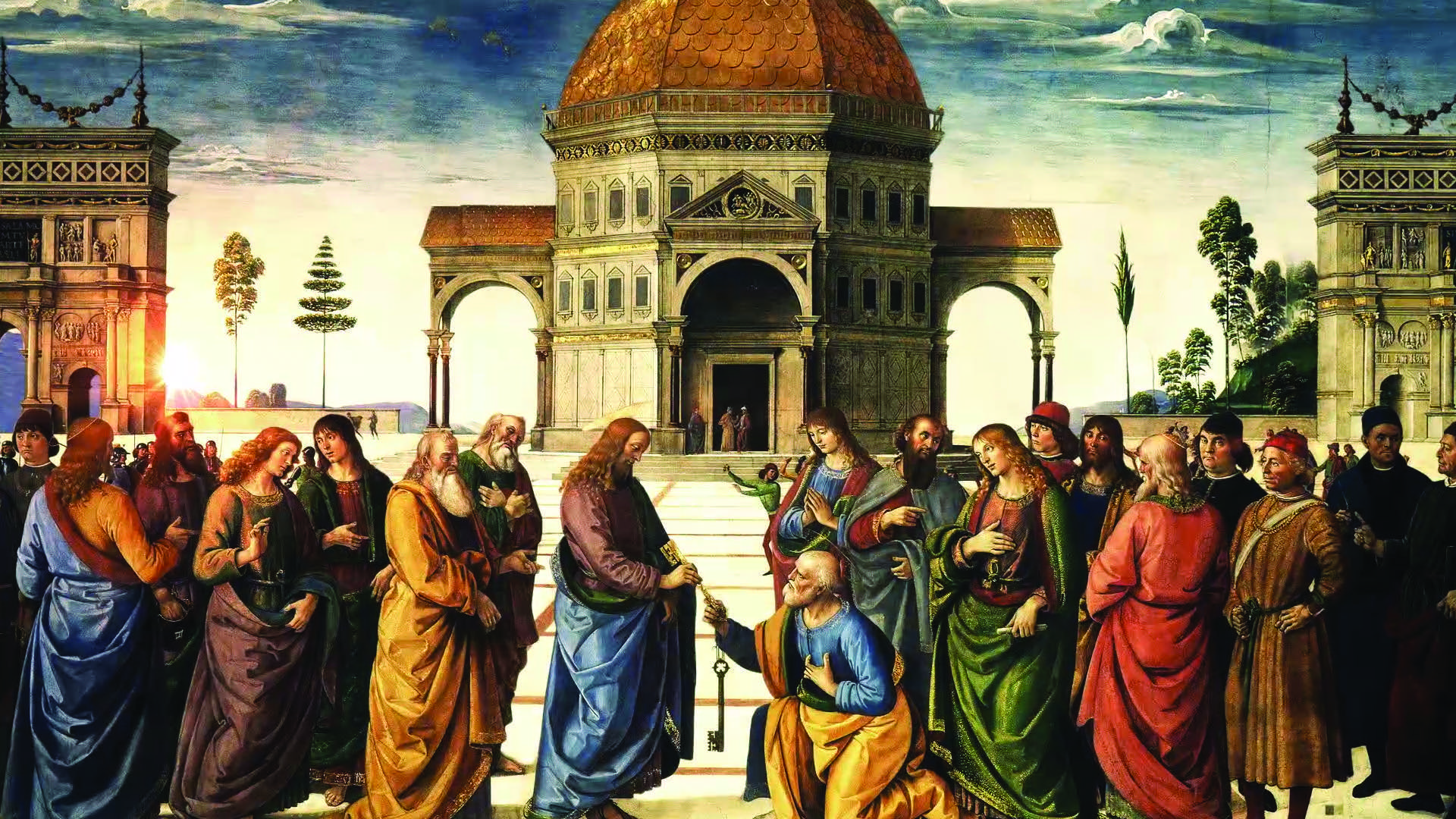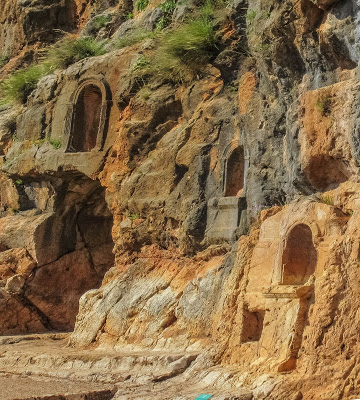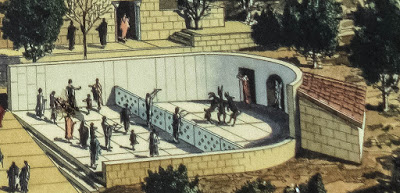Jesus brought his disciples to the region of Caesarea Philippi before his final journey to Jerusalem, as described in the Gospel of Matthew. They had been together for almost three years and were followed by crowds wherever they went. Here, in this northeastern area of Israel not frequented by pious Jews, Jesus would have some private time to prepare his disciples for the inevitable.

Jesus’ teaching in Caesarea Philippi would be the first time he spoke about his future church, and it seems curious why Jesus chose this faraway, pagan location for one of his most important lessons and revelations. Jesus, however, was a masterful, intentional teacher and storyteller. He must have selected this area for a powerful visual illustration of the disciples’ future challenges and responsibilities.
I had the privilege of visiting Caesarea Philippi, now known as Banias, in November 2022. Banias, on the foothills of the beautiful Mt. Hermon, is lush and teeming with trees and wildlife. The beautifully shaded, rocky area gives shelter to rock badgers, or hyraxes, that scamper in and out of the crags. Driving from the northern Galilee region to this most northern area of Israel caused me to consider the long distances Jesus and his disciples walked. The terrain is rugged and hilly, and as we drove, I reflected on how Jesus’ journey must have been long and arduous. I wondered if any of his disciples complained about their sore leg muscles like I would have.
Some researchers say Jesus and his disciples would have traveled by boat from Magadan to Bethsaida before their trip to Caesarea Philippi. Bethsaida is located on the northern shore of the Sea of Galilee. This body of water is nearly 700 ft below sea level. From there, they likely spent some days making the 25 mile ascent to Caesarea Philippi, which was located at an elevation 1,150 ft above sea level.

At Caesarea Philippi, Jesus and his disciples would have seen the largest rock formation in Israel with pagan statues and at least fourteen temples in the background. Without understanding the uniqueness of this visual context, a person reading Matthew 16:13 might imagine the setting to be what classical painters of religious stories created. We can’t be too upset with these Renaissance artists, as they had no opportunity to travel to the real setting. Below is a painting without an accurate background.

Figure 1 Renaissance Painting of Jesus handing Peter the Keys to Heaven at Caesarea Philippi
The Ancient History of Caesarea Philippi
In Old Testament times, Caesarea Philippi, then known as Banias, sat at the base of Mount Herman. The early Canaanites worshiped Baal at Banias, and prisoners were thrown into the “Gates of Hell”, to determine guilt for a crime. Ferocious waters gushed from a very large spring of this limestone cave. In ancient times, the water was fast-moving and would have propelled the bodies over the rocks, and death was guaranteed. The waters filled with human or animal corpses must have been a frightening sight. Eventually, the cult of Baal was replaced with the worship of Greek fertility gods and Caesar.

Figure 2 The Cave of Pan at Banias today
To the ancient Greeks who settled in this area, the cave at Caesarea Philippi was the gate to the underworld, where fertility gods dwelt during the winter and then returned to the earth each spring. The people also believed the cave held the “Gates to Hades.”
The location of Caesarea Philippi is significant because the entire region was considered the domain of the Nephilim and their disembodied spirits. Mount Hermon was ground zero for the Genesis 6 transgression and where we are told in 1 Enoch that the fallen elohim made their pact to take human women. Additionally, this is also the location where King Jereboam constructed his adulterous center of worship.
At the time of Jesus, the most important god in Caesarea Philippi was Pan, the Greek god of shepherds and the wild. Pan’s hindquarters, legs, and horns are like that of a goat, while his upper body was of a man. The Greeks believed Pan was born in this cave, and he is often associated with music and fertility. Each spring, the people of Caesarea Philippi engaged in wicked deeds, including prostitution and sexual interaction between humans and goats to entice the return of Pan.

Statue of Pan at the Athens Archeology Museum
When the Romans conquered this territory, Herod the Great gave it to his son Philip who rebuilt the city, named it after Caesar, with his name inserted to distinguish it from Caesarea Maritima, and added a Roman temple. During the early years of the Roman occupation, the local people continued to focus their worship on Pan and other Greek gods at the shrines and temples.

Figure 4 Niches in the limestone where Greek Statues were placed are still seen today
The ruins of the temples still exist today, and visitors can see the inscription of dedication to Pan inside the largest niche. In ancient times, statues were placed by the Greeks in these large niches carved into the limestone of the massive cliff. Most prominent were the Temple of Pan and the Temple of the Dancing Goats.

Figure 5 Temple of the Dancing Goats
Yes, there were dancing goats back then. A large market was a short distance from the temple area where goats were sold for sacrifice to Pan. An orchestra near the temple provided music, and worshipers would “dance” with the goats before leading them for sacrifice.
At the rear of a temple was the Cave of Pan. It was at the foot of a cliff where spring water flowed directly from the cave’s mouth. This fast-moving stream, the beginning of the Jordan River, was created by seventy-two springs originating in the bowels of the mountain. The waters were so deep that ancients were unable to plumb the depths and therefore considered it bottomless. Over the centuries, earthquakes have destroyed the cave, and modern engineering has diverted the waters, so we no longer see the furious torrents of water.

Figure 6 Cave of Pan or the Gates of Hell/ Hades today
It was in this cave the worshipers threw their slaughtered goats into the powerful waters. The sacrifice was accepted by Pan if the goat sank. If the goat floated, it meant Pan had rejected their offering, and the worshipers were required to purchase another goat and try again. The goat’s bodies were retrieved and buried in the Sacred Temple of the Goats. I believe that the goat carcasses were likely retrieved, and their meat was sold in the commercial area of Caesarea Philippi, as was the practice of many pagans in ancient times. It was said the waters of the Cave of Pan were always colored red from the blood.
Jesus Challenges His Disciples at Caesarea Philippi
The gospel in Matthew 16:13 provides the most detail of Jesus’ important teaching in this setting, rife with references to pagan symbols.
“Now, when Jesus came into the district of Caesarea Philippi, he asked his disciples, “Who do people say that the Son of Man is?” And they said, “Some say John the Baptist, others say Elijah, and others Jeremiah or one of the prophets.” He said to them, “But who do you say that I am?” Simon Peter replied, “You are the Christ, the Son of the living God.” And Jesus answered him, “Blessed are you, Simon Bar-Jonah! For flesh and blood has not revealed this to you, but my Father who is in heaven. And I tell you, you are Peter, and on this rock I will build my church, and the gates of hell shall not prevail against it. I will give you the keys of the kingdom of heaven, and whatever you bind on earth shall be bound in heaven, and whatever you loose on earth shall be loosed in heaven.”
Jesus proposed two questions to his disciples. The first, “Who do people say the Son of Man is?” could be easily answered by their observations as they traveled with Jesus. Herod promoted a rumor that Jesus was the resurrected John the Baptist. Some people believe Jesus to be Elijah, whose return was anticipated as he would announce the coming Messiah. Some thought Jesus was Jeremiah because of their similar warnings.
Jesus’ second question is one we should all answer, and Peter’s response was perfect: “You are the Christ, the Son of the living God.” Peter wasn’t the first to declare this revelation. The Gospel of John tells us the disciples knew Jesus was the Son of Man, the Messiah or Christ, and the Son of God when they began to follow him. At Caesarea Philippi, Jesus wanted each disciple to fully understand His identity, not only God the Father’s. For three years, the disciples had heard his teachings and witnessed his healing ministry, but Jesus wasn’t just a miracle worker and healer. He wanted to be certain these disciples understood his complete, divine nature and to know the sovereignty of his Father’s kingdom was available for everyone to experience for all time.
Now, imagine Jesus standing at a distance, looking at this cliff with the pagan statues in the niches. Since this was a pagan “red light zone,” it is unlikely Jesus and the disciples were standing close to this heathen area of worship. He then said to Peter and his disciples, “And I tell you, you are Peter, and on this rock I will build my church, and the gates of hell shall not prevail against it.”
This day in Caesarea Philippi is when Jesus founded his church. His church would symbolically be built on the “rock” of Caesarea Philippi, one then filled with niches for pagan idols and where ungodly beliefs and values dominated. This huge rock’s destiny was like so many ancient tells in Israel: to be crushed and destroyed as rabble, and where God’s kingdom would be built on its ruins.
Anyone familiar with this part of the ancient world knows earthquakes, wars, and other forms of destruction will surely decimate not only man-made buildings but also massive outcrops like in Caesarea Philippi. Jesus wasn’t suggesting a church building would be constructed on top of these pagan sites, but that his church was to be built stone by stone using people like Peter, the disciples, and you, and me. Jesus had given Simon Peter a new name, “Petros,” meaning a single stone. “Petra,” the term Jesus used for his future church, means a massive rock or formation; fixed, immovable, enduring.
In the ancient world, gates were defensive structures to keep the enemy out, but Jesus doesn’t want us cowering behind them. When he stated, “and the Gates of Hell will not prevail,” Jesus was suggesting those gates should be attacked. His followers were challenged to not hide from evil and would be commanded to storm the Gates of Hell, which would not hold up under the triumphant forces of Jesus’ church.
Then, Jesus said, “I will give you the keys of the kingdom of heaven, and whatever you bind on earth shall be bound in heaven, and whatever you loose on earth shall be loosed in heaven.” Catholic theologians have historically believed this passage proves Peter was intended to be the head of the Christian church. But, if we look at the early church, it was both Peter and James, the brother of Jesus, who would lead the church then centered in Jerusalem.
Who exactly holds the keys to Heaven is a topic that is widely debated. Some people believe that Peter was given the keys, and that point of view can be supported as Jesus intended to use him in unique and miraculous ways. Peter was the first to use the keys of the kingdom when he delivered the first sermon after Pentecost that would electrify and grow this new church. Peter would break down the Kingdom’s barriers between Jews and Gentiles when he met with Cornelius. Jesus Christ’s church’s gate was now unlocked and would remain wide open for all who enter through the precious blood of Jesus Christ.
Others believe the keys were given to the disciples. This is supported by Matthew 18:18, when Jesus repeated his instructions, where he was clearly speaking to all of them. “…whatever you bind on earth shall be bound in heaven, and whatever you loose on earth shall be loosed in heaven.” In our individualist culture, we often interpret “you” in scripture as singular. Often, a more correct way is to view “you” as plural.
Many theologians point out there was more than one key as Jesus used the plural, “keys.” They emphasize that all believers hold the keys to the kingdom of Heaven as we believe, forgive, serve, trust, and pray. Perhaps the keys to the Kingdom of Heaven were meant to set us free from bondage to grow Jesus’ church and bring glory to God.

Figure 7 Caesarea Philippi in ancient times
After the visit to Caesarea Philippi, Jesus presented the disciples with another word of caution: “If anyone is ashamed of me and my words, the Son of Man will be ashamed of him when he comes in his glory” (Luke 9:26). He understood his followers would face ridicule and resistance as they tried to confront evil.
The disciples must have felt overwhelmed by Jesus’ challenge and teachings. He was now commissioning them to an enormous task: to attack evil and to build his church on the places that were filled with moral corruption. His kingdom would grow and expand to glorify God.
Now, look at these photos again and imagine you are amongst the disciples on that day in Caesarea Philippi listening to Jesus’ message. Jesus isn’t talking to just those in church buildings and Christian schools; He is talking to each of us in our daily lives. Are you on defense or offense in the Kingdom of God?
In the Book of Job 36:2, Elihu says, “I have yet something to say on God’s behalf.” as he chastens Job’s three friends. Many people might think the privilege and responsibility to speak on God’s behalf only applies to clergy who are gifted in teaching or evangelism, but scripture reminds all believers we are not to hide our candle under a bushel but be “a city set on a hill.”
Even if we have a nervous temperament or a retiring disposition, we’re not to indulge our weaknesses and be useless to the church. Like Peter and John said, “I have no silver and gold, but what I do have I give to you.” Don’t cower and hide because your fears of family disharmony or of appearing foolish or ill-equipped are greater than sharing what God has set on your heart.
We might not have the opportunity to preach on the mountaintop, but the praises of Jesus should be heard in our homes and during our ordinary daily lives. As Charles Surgeon once preached, “Our simple words will be refreshing to ourselves, cheering to the saints, useful to sinners, and honoring to our Savior.”
Note for those who wish to travel to see Caesarea Philippi: Many areas, including this site are closed for visiting because of the hostile actions from Hezbollah to the north. Hundreds of thousands of Israelis have been evacuated from this region and are now refugees. Pray for peace.
Scripture is taken from the New International Version (NIV)
Just read this Donna, amazing! Well done.
Plan to send to my friend in France who believes Jesus is one God of many (not the only way). She is seeking though and I believe Jesus will show her the way if she continues to seek Him.
Love,
Jeanne
LikeLike
I’m just wondering what your source is for the descriptions off the temples and sacrificial acts of goats and humans? I’m just wanting to confirm the accuracy for a sermon – I’m not arguing you’re wrong age al, I just need a reference is all.
LikeLike
I sent you an email, Greg.
LikeLike
the email attached to my name above is inactive – try revgregcolby[at]gmail[dot]com
LikeLike
I sent you an email to your new address. Let me know if you got it. Check out “Away in a Manager” for an advent teaching.
LikeLike
Pingback: Rocks and Tombs – Sea & Anchor: Pastoring a Cast of Characters
Thank you so much for clarity. I find your exposition both historical and literary contextually relevant to the teaching that I believe Jesus had in mind. May I ask you to furnish me with the sources you used? Remain blessed.
LikeLike
Hi Donna,
I love this piece. As a student of history and theology I am always concerned about the cultural/historical setting of Scripture passages. BTW, I found out about you only several days ago, while researching my ancestor Mehitabel Braybrooke Downing. Now I have your book on order. It appears that we are distantly related.
Grace and Peace,
Dane
LikeLike
Donna, I’m reading Reversing Hermon so this article was very interesting and informative. Thanks, Jatonna
LikeLike
Hi Could you please send your sources for this, I’m visiting Banias in June!
LikeLike
I’m getting ready for a last minute trip to Europe so I don’t have much time. Ray Vandelaan is my primary inspiration. I’ve also researched in books such as Illustrated Guide to Biblical Geography, A Visual Guide to Bible Event, A Visual Guide to Gospel Events, numerous Biblical archeology books and resources from the archives of the Biblical Archaeology Society.
LikeLike
Googled “Gates of Hell Caesarea Philippi” and found this, read the whole thing top to bottom and learned a LOT. Your efforts are appreciated.
LikeLike
I think “petra” refers to the words of the Father, the promise to send a Savior. The keys are the key of knowledge and the key of faith – the gospel understood and believed. The gates of hell is a metaphor for death. The gospel translates us from death to life. And in regards to binding and loosing, one should refer to Luke 4 where Jesus reads from the Isaiah scroll at Chapter 61. Jesus came to “bind up the brokenhearted.” Again, it is the gospel that is in view. Binding and loosing have nothing to do with church authority. They are the healing and freeing effects of the good news. Every Christian is to share the petra, the word of good news. Death is overcome by this gospel, which will not return void.
LikeLike
Pingback: Storming the Gates of Hell | The Ewellogy
I love Ray Vander Laan and first learned about it from him. I visited the site and have added info from a Divine World Council point of view.
LikeLike
thank you for this article, i had been at the cave a couple of years before but somehow i wanted to go back there after i read on line that petrus had been there teaching his followers. so last week i was in north israel ( sept 2025) and we went to Banias again. i really took in the place this time for real, and we did a beautiful hike along the river for a couple of miles. so happy to read this article finally, which proves to me even more the significance of the place . i am a historian from amsterdam, but my partner is a kibbutznik from an adjacent kibbutz, and it was so special to be there as the only persons , as there were no tourists , as we visited during the war, as you stated in the bottom of your article. let’s hope the hostages will really be returned to their families 7 hours from now.
LikeLike